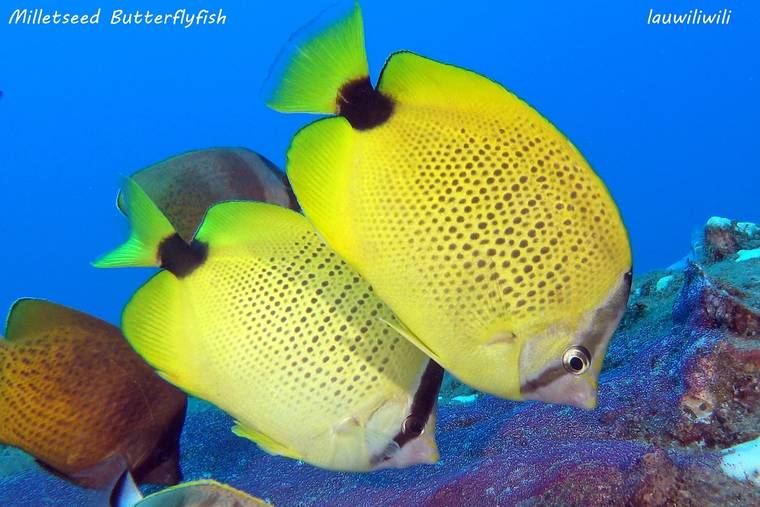This six-inch-long, bright-yellow fish is Hawai‘i’s most abundant butterfly fish. On the deep-water ledges off the island of Ni‘ihau there are schools of over 1,000 milletseed butterfly fish, and diving with them is like being in a yellow snow storm. Lauwiliwili is endemic to Hawai‘i, which means it occurs nowhere else on Earth, and divers come from around the world to see our “clouds of butterfly fish.”
This six-inch-long, bright-yellow fish is Hawai‘i’s most abundant butterfly fish. On the deep-water ledges off the island of Ni‘ihau there are schools of over 1,000 milletseed butterfly fish, and diving with them is like being in a yellow snow storm. Lauwiliwili is endemic to Hawai‘i, which means it occurs nowhere else on Earth, and divers come from around the world to see our “clouds of butterfly fish.”
What is interesting about lauwiliwili is most butterfly fish live in small schools or travel in pairs. The milletseed butterfly fish is very common in shallow-water lagoons, feeding all by itself or living in giant schools in deeper water. They feed on floating plankton and also small marine creatures that live on the reef, and even on the eggs of other fish. In Maui I sat in a school of 50 millet-seed butterfly fish filming them while they were feeding on millions of purple sergeant fish eggs. It was like sitting in the middle of a field of purple and yellow flowers blowing in the wind.
Lauwiliwili got its Hawaiian name because it looks like the flower of the wiliwili tree. Many of the Hawaiian fish names relate to plants of animals on land that they look like or connect with. The common name “milletseed” was named by a Frenchman who described the fish as having seed-like dots on its bright-yellow body.
Us scuba divers have fun diving in the big schools of millet-seed butterfly fish as we scratch the bare reef with our fingers, scraping off little bits of algae. Hundreds of lauwiliwili will zoom in to eat the floating algae, and sometimes there are so many fish you can’t even see the diver. I have seen schools of lauwiliwili follow monk seals around for the same reason. The seal will dig in the reef looking for eels and lobsters to eat and the butterfly fish gobble up all the tiny marine creatures the seal scares up off the reef.
You can see lauwiliwili in action in the movie “The World’s Guide To Hawaiian Reef Fish” at underwater2web.com, and also have your kids see the millet-seed butterfly fish in person in our nonprofit Coral Reef Kids Camp with Reef Guardians Hawai‘i.
•••
Terry Lilley is a marine biologist who lives in Hanalei and is co-founder of Reef Guardians Hawai‘i, a non-profit on a mission to provide education and resources to protect the coral reef. To donate to Reef Guardians Hawai‘i go to www.reefguardianshawaii.org.



